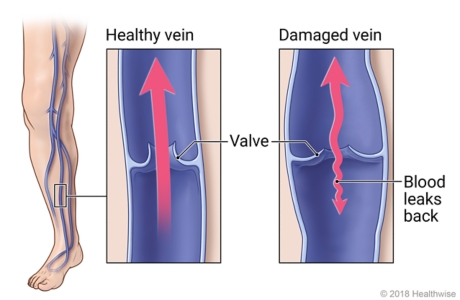Venous Insufficiency
Venous insufficiency is a problem with the flow of blood from the veins of the legs back to the heart. It's also called chronic venous insufficiency or chronic venous stasis.
Your veins bring blood back to the heart after it flows through your body. Veins have valves that keep the blood moving in one direction—toward the heart. But with venous insufficiency, the veins of the legs might not work as they should. This can allow blood to leak backward. Fluid can pool in the legs. This can lead to problems that include varicose veins.
Symptoms
Venous insufficiency

In venous insufficiency, the valves in the veins have become damaged. These valves normally keep blood flowing toward the heart. But damaged valves allow some blood to leak backward. This causes the veins to become overfilled. Fluid seeps out of the engorged veins into surrounding tissues. This may result in tissue breakdown and venous skin ulcers.
What are the symptoms of venous insufficiency?
Symptoms of venous insufficiency affect the legs. Symptoms may include swelling (often in the ankles), cramping, aching, a heavy feeling in the legs, or varicose veins. You may also have skin problems like itching, sores, or changes in skin color.
Causes
What causes venous insufficiency?
Venous insufficiency is sometimes caused by deep vein thrombosis and high blood pressure inside leg veins. People who are pregnant, older, overweight, or have a family history of varicose veins are more likely to get it. So are people who smoke or stand for long periods of time.
Diagnosis
How is venous insufficiency diagnosed?
Your doctor can diagnose venous insufficiency by examining your legs and by using a type of ultrasound test (duplex Doppler) to find out how well blood is flowing in your legs.
Treatment
How is venous insufficiency treated?
Your doctor may recommend wearing compression stockings to help relieve symptoms. Your doctor may also suggest other steps to try at home, such as getting regular exercise. Medicine or a procedure can also be treatment options. Procedures can close the vein, remove the vein, or improve blood flow.
Copyrighted material adapted with permission from Healthwise, Incorporated. This information does not replace the advice of a doctor.



